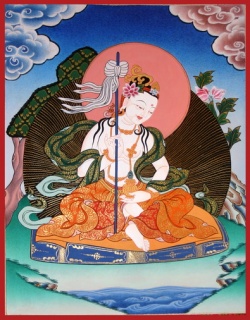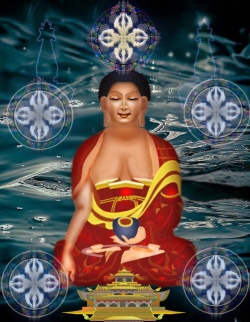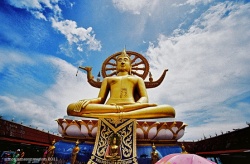Buddhist Concept of Human Being
- Buddhism is a way of life, and in the ultimate sense of the term, it cannot be called religion which is concerned with the belief in God.
Normally, Buddhists speak of Buddhism as Buddhasāsana or Buddha-Dhamma meaning the Buddha’s teachings.
However, by common usage of language, the Buddhists may be allowed to call Buddhism as a religion, because they do believe in the moral law of karma.
On the other hand, though the Buddha preached the doctrine of karma, he could be called a kiriyavādin, Howsoever his teachings are far more than a mere notion of the karma-doctrine.
He was criticized as a revolutionist because of his replacing Ātmavāda and self-mortification with Anattāvāda and the Middle Way respectively.
Likewise, by the rejection of the caste-system and also of the idea of God he was reckoned as a reformist.
By discovering the Four Noble Truths, he is known as a reconstructionist.
- The philosophy of Buddhism is chiefly psychological, and its ethics cannot be entirely separated from its metaphysics.
The ultimate purpose of all its philosophy is not intellectual but moral – the attainment of freedom from the suffering or Nibbāna (Skt. Nirvāna) which is the Buddhist Summum Bonum.
- We are told in the Pitaka that the Buddha took no interest in purely metaphysical questions, because they appeared to be questions without profit, and a mere waste of time. Even in his most abstruse teachings his purpose is ethical.
- The Buddha avoided discussion about purely metaphysical questions, such as whether the world is eternal or not, and so on, which are regarded as vain, for it does not take man nearer to his goal.
The world of the Buddha was that of the six-feet-long-living body along with perceptions and thoughts, where the root-cause of suffering and samsāra, namely, avijjā, can be uprooted.
Therefore we can say that Buddhism does not agree with the speculative metaphysics.
In Buddhist philosophy, the metaphysical doctrine must relate to the ethical goal of life as the Middle Way (majjhimā-patipadā).
- The Buddhist idea of existence or the metaphysical doctrine, it is said, can be viewed under the highest forms of explanation, viz., the five khandhas, the eighteen dhātus and the six āyatanas, in the light of the Four Noble Truths.
In this way, the Buddha divided truth into two kinds, apparent (sammuttisacca) and ultimate (paramatthasacca) .
The latter is actually emphasized by the Buddha. The world of human beings, and its existence, for instance, do not really exist as we apparently perceive them.
They are naturally described as “the conditioned existence’ (sańkhata), which can be explained in terms of five khandhas, namely, matter (rūpa), feeling (vedanā), perception (saññā), mental formations (sańkhāra) and consciousness (viññāna).
These five constituents are also called nāma-rūpa.
According to Abhidhamma, rūpa signifies fundamental unit of matter, material changes, and the twenty-eight derivative materials which originate from four conditions, viz., “karma”, “citta”, “nutriment” and “temperature”. Nāma refers to consciousness (citta) and its mental concomitants (cetasikas).
- In the realization of existence, we will begin with the analysis of the five khandhas as the reality, which represents “life as it is”, but it is not complete in itself, for as usual we are dealing with “life as directly concerning world”.
Therefore, the analysis of āyatanas has been made with a view to show the world-related life, especially by means of perceiving the world through six sense doors.
Here the phenomenal existence can be explained in terms of the six sense-organs and their six sense-objects, the function of which is to develop perceptual awareness.
Not only this, it also evolves as a whole in the phenomenal world (samsāra).
must remember that the five khandhas and the twelve āyatanas never function in isolation in the way we have described.
But we have discuss them in isolating one from the other in order to comprehend their relative positions that constitute personality.
- The Abhidhammikas classify the ultimate truth into citta, cetasika, rūpa and Nibbāna and admit that the first three do ‘conditionally exist’ (sańkhata), but the last one ‘unconditionally exist’ (asańkhata).
Therefore, the Theravāda Buddhist philosophy is known as realism as it upholds the existence of the ultimate truths.
In this connection, the Sarvāstivāda, the Vaibhāsikas, the Sautrāntikas and the Puggalavāda on beings have been elaborately and separately brought out in comparison with the other schools of thought.
It should be mentioned here that no Buddhist school admits the definite assertible self, as it would go against the fundamental teachings of the Buddha.
The Puggalavādins’ conception of self is, therefore, neither definite nor indefinite self.
- The idea of existence classified in terms of khandhas, dhātus and āyatanas as mentioned above, can be well understood only through the causal law of existence, especially the law of Tilakkhana and that of Paticcasamuppāda, which completely explain the exact way in which the personality is evolved and disintergrated.
The law of Tilakkhana helps to explain the nature of conditioned things in the light of impermanence, suffering and not-self.
The basis of debate between the Buddhists and Hindus is the concept of self.
If the causal law of nature is understood in its proper perspective, there will hardly be any scope for further confusion in this matter.
According to the causal law of nature, the effect arises from an aggregate of causes and conditions.
Because of ignorance arise consciousness, karma-formation, and so on.




